(HIpE) 2009 Program and Abstracts - Health Sciences - Curtin ...
(HIpE) 2009 Program and Abstracts - Health Sciences - Curtin ...
(HIpE) 2009 Program and Abstracts - Health Sciences - Curtin ...
You also want an ePaper? Increase the reach of your titles
YUMPU automatically turns print PDFs into web optimized ePapers that Google loves.
<strong>Abstracts</strong>Interdisciplinary Care within Western Australia’s State Major Trauma ServiceSonja De Munck & Jessica HoldingRoyal Perth HospitalJessica.Holding@health.wa.gov.auPatients who have sustained injuries to multiple body systems through trauma are a complex, high cost group ofpatients that often require multiple procedures, interventions <strong>and</strong> resources throughout their hospital admission.In November 2004, Royal Perth Hospital was designated the state’s Adult Major Trauma Centre. The traumaservice consisted of a specialist medical team, trauma case manager <strong>and</strong> senior occupational therapist. Traumapatients were scattered around the hospital making it difficult to effectively coordinate interdisciplinary care <strong>and</strong>discharge planning. In February 2008, Western Australia’s 30 bed State Major Trauma Unit was openedboasting both a team of specialist general <strong>and</strong> orthopaedic surgeons, as well as occupational therapists,physiotherapists, social workers, clinical psychologists, pastoral care, a speech therapist, pharmacist <strong>and</strong>dietician.The aim of the State Major Trauma Service is to ensure the medical, physical, cognitive, functional <strong>and</strong>psychosocial needs of the patient are met in an effective <strong>and</strong> timely manner through communication <strong>and</strong>collaboration between health professionals, the patient <strong>and</strong> family. It is anticipated that in addition to benefits tothe patient, costs to the health care system are reduced by minimising duplication of services <strong>and</strong> decreasinghospital length of stay. A case management model is utilised where patients <strong>and</strong> their family members liaisedirectly with one team member who is then able to communicate with relevant team members. Anecdotalevidence suggests this model is effective in ensuring the patient remains informed <strong>and</strong> empowered throughouttheir hospital journey. An overview of interdisciplinary care provided by the State Major Trauma Service will bediscussed.Interprofessional <strong>and</strong> international clinical education: Working, living <strong>and</strong> learning togetherin China, India, South Africa <strong>and</strong> UkraineNigel Gribble & Trevor Goddard<strong>Curtin</strong> University of Technologyn.gribble@curtin.edu.auFlint states “…an urgency exists for innovative interdisciplinary education approaches that "mimic" life in thecommunity <strong>and</strong> the natural environment so that the boundaries between education <strong>and</strong> community life becomeless defined <strong>and</strong> therefore, more integrated.” Annually, 90 allied health students from the <strong>Curtin</strong> UniversityFaculty of <strong>Health</strong> Science undertake Go Global - a four week clinical education placement in China, India, SouthAfrica or Ukraine. With interdisciplinary practice widespread in the Australian healthcare system, it is imperativethat students demonstrate relevant skills <strong>and</strong> behaviours to work effectively as healthcare workers.<strong>Curtin</strong>’s interprofessional international program provides a unique opportunity for Occupational Therapy,Physiotherapy, Pharmacy, Nursing <strong>and</strong> Human Communication Science students to live <strong>and</strong> work together inculturally diverse social <strong>and</strong> health milieus allowing the roles, skills <strong>and</strong> philosophy of the respective disciplinesto be understood.The international clinical education program evolved from the service learning models of Kenworthy-U’ren <strong>and</strong>Peterson <strong>and</strong> Godfrey et al. Each student cohort completes a cultural orientation program before travelling tothe host sites. Students deliver services to the clients <strong>and</strong> children in the same location year after year. For thefinal three weeks, students practice autonomously with guidance from the clinical supervisor provided via phoneor email exchanges. The interprofessional make-up of each cohort enhances the quality of services delivered toeach resident or child. It is the autonomous practice <strong>and</strong> reciprocity factors that allow the program to meet Flint’schallenge bringing diverse allied health students together.This innovative interprofessional education program is creating professionals with the <strong>Curtin</strong> Graduate Attributeof ‘recognising <strong>and</strong> applying international perspectives’ able to practice in a globalised environment asinternational citizens.<strong>Health</strong> Interprofessional Education (<strong>HIpE</strong> <strong>2009</strong>) — Student Conference 9



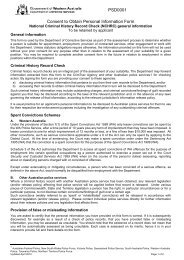
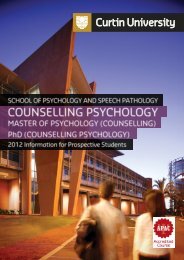
![Mental health commission report July 2010 - June 2011 [.pdf]](https://img.yumpu.com/50755705/1/184x260/mental-health-commission-report-july-2010-june-2011-pdf.jpg?quality=85)
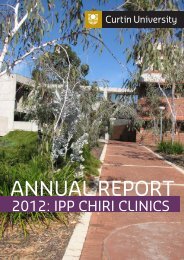

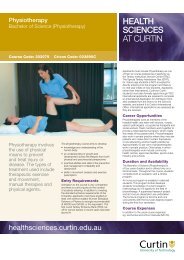
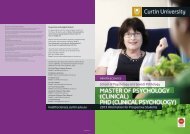
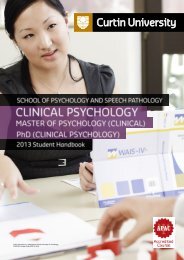

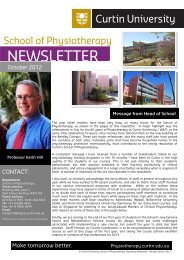
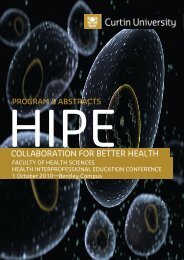
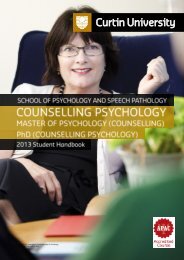
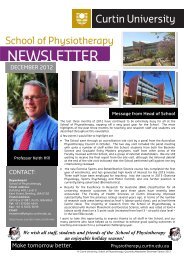
![2007 Annual Report [.pdf] - Health Sciences - Curtin University](https://img.yumpu.com/44476724/1/184x260/2007-annual-report-pdf-health-sciences-curtin-university.jpg?quality=85)